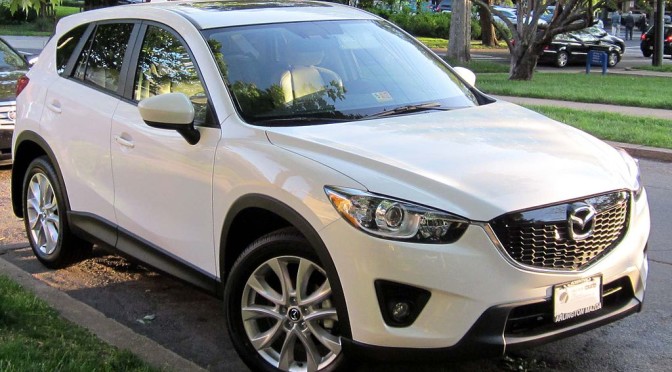This is the third installment in a series of the best vehicles to be in when it comes to rollover survival. I wrote about the best minivans for rollover protection last year and recently wrote about the safest mid-sized family cars of 2016 for rollover survival. However, what does the field look like when it comes to small SUVs and crossovers? Are the safety features that make the difference for cars also important in crossovers, and if so, which ones have them?
This article is designed to answer all of these questions. If you’re interested n similar articles I’ve written, check here: I’ve written similar articles on safe vehicles for side impact collisions (here are the safest 2015 cars, small cars, minivans, SUVs and crossovers, and small SUVs and crossovers for surviving side impacts). Now let’s take a look at which factors play a role in surviving a rollover in a given vehicle.
What does a small SUV or crossover need to keep my family safe before or during a rollover?
1. Electronic stability control. ESC lowers your rollover risk by automatically braking individual tires to help you steer in your intended direction. It’s like an advanced version of ABS, and its estimated to cut your risks of a fatal single vehicle crash in half. Like a seat belt and a frontal airbag, you want to make sure ESC is present in any vehicle you drive.
2. Rollover-sensing side airbags with head and torso protection. If at all possible, make sure whatever you drive features side airbags programmed to deploy during impending rollovers. Your odds of surviving a rollover drop significantly if you bang your head against the windows, roof rail, or vehicle frames, and you can’t control what your body does once a rollover begins.
3. A strong roof. Finally, you need a strong roof to keep your occupant cabin in one piece during an active rollover. If the roof caves in during a rollover, you aren’t going to live to see the end of one. Similarly, if the roof starts to buckle, your seat belt might detach from the B frame and you’ll likely be ejected from the vehicle. If not, you probably won’t be in position for your side airbags to help you. In short, you need a strong roof to make it through this kind of crash.
How strong should an SUV / crossover’s roof be to keep my family safe in a rollover?
That’s an excellent question. The NHTSA requirement for how much force a roof must support before caving in by several inches used to be 1.5x the weight of a vehicle for vehicles that weighed less than 6,000 pounds. This wasn’t enough. A vehicle can easily put several times its own weight on its roof during a rollover involving a fall of just a few inches.
The IIHS started their own roof strength test and made a strength-to-weight ratio, or SWR, of 4.0 or better, necessary for a “good” rating. Their threshold for an “acceptable” rating is 3.25x, while their threshold for a “marginal” rating is 2.5x. Below that, such as in the 1.5x range the NHTSA used to find acceptable, the IIHS marks a roof as poor.
Thanks to the IIHS, the NHTSA finally increased their SWR requirement to 3x the weight of the vehicle for vehicles under 6,000 pounds before the roof could cave in by several inches. They also created a requirement for vehicles between 6,000 and 10,000 pounds of 1.5x vehicle weight. Neither requirement is enough, but both are better than what the requirements used to be.
Given these factors, I put together a list of the best model 2016-17 small SUVs and crossovers to be inside when trying to avoid or survive rollovers. I weighed and combined the three metrics I described above for optimum rollover safety. To only consider the best of the best small SUVs and crossovers, I limited the list below to vehicles with ESC, roofs with SWRs of 5.0 or greater, and roll-sensitive side airbags; I then sorted these vehicles by roof strength. Each crossover is identified as a 2016 “Top Safety Pick+” by the IIHS, which means they all feature good frontal, side, roof, and head restraint scores, as well as advanced or better frontal crash prevention with optional features. I used the TSP+ as another filter to ensure these vehicles were at the forefront of recommended technologies.
The safest small SUVs and crossovers for avoiding and surviving rollovers in 2016
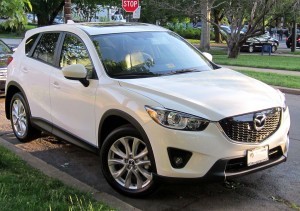 5.47: 2013-2016 Mazda CX-5
5.47: 2013-2016 Mazda CX-5
When it comes to roof strength in the small SUV / crossover market, the best US vehicle you can be in is the Mazda CX-5. It’s capable of supporting close to 5.5x its weight before caving in by 5 inches, and holds a slight edge over its closest competitor, the Tucson. Like every other vehicle on this list, it also comes with roll-sensitive airbags and ESC, as well as a “2016 Top Safety Pick” rating by the IIHS.
Unlike the other vehicles on this list, there isn’t a previous-generation CX-5 to look through for savings; however, since the strengths in this model date back to model year 2013, you might be able to find significant savings in the used market.
My full 3 across car seat guide to the CX-5 is here.
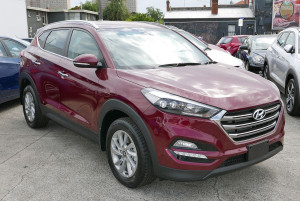 5.37: 2016 Hyundai Tucson
5.37: 2016 Hyundai Tucson
Hot on the heels of the CX-5 is the Tucson with a strong SWR of 5.37. Unlike the CX-5, there aren’t any previous years in this generation yet, as this is the first model year of the current gen. To see any savings, you’ll need to go to the previous gen Tucson, which does still feature a good SWR of 4.43, ESC, and roll-sensitive side airbags.
My full 3 across car seat guide to the various generations of the Tucson is here.
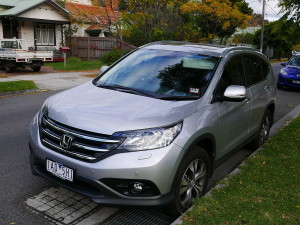 5.08: 2012-2016 Honda CR-V
5.08: 2012-2016 Honda CR-V
The current generation CR-V makes a strong showing with its SWR of 5.08. If you’re interested in the previous generation for savings, given the high resale value of the CR-V, keep in mind that while the 2007-11 model years do feature ESC and roll-sensitive side airbags, the roof is rated as marginal by the IIHS with a SWR of 2.80.
That said, the IIHS also estimated the 2008-11 4WD and 2WD CR-Vs to have driver death rates of 17 and 19, respectively, with only 2 of those deaths in either configuration estimated to come from rollovers. This suggests that in day-to-day driving, at least, the CR-V was already a very safe vehicle in its prior generation, as well as one unlikely to lead to deaths from rollovers, despite its marginal roof score.
My full 3 across car seat guide to the various generations of the CR-V is here.
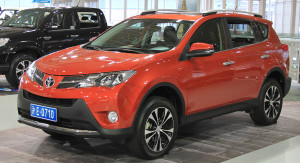 5.00: 2013-2016 Toyota RAV4
5.00: 2013-2016 Toyota RAV4
Finally, the RAV4 just makes the cutoff with an SWR of exactly 5.00. As with the CR-V, if you look to the prior generation for savings, keep in mind that while the RAV4 does feature roll-sensitive airbags from 2007-12 as well as ESC, the roof is only rated as acceptable by the IIHS with a 3.46 SWR.
That said, even though the SWR is better than that of the CR-V, the 2008-11 4WD and 2WD RAV4s have driver death rates of 19 and 35, with 2 and 10 deaths in the respective configurations estimated to result from rollovers. I’m not sure why the 2WD RAV4 had a much higher overall and rollover-specific death rate; it’s entirely possible that it could be due to statistical noise. However, it’s something to keep in mind.
My full 3 across car seat guide to the various generations of the RAV4 is here.
In conclusion, any of these crossovers will be among the absolute safest you can be in during a rollover today. They feature ESC to reduce the risks of rollover involvement to begin with, rollover-sensitive side airbags to protect you should rollovers occur, and strong roofs to preserve your occupant space and allow your seat belts and side airbags to do their jobs while the rollover occurs. These are life-saving technologies, and we’re blessed to live in an era where they exist and are widely available and increasingly affordable.
What do I do if the SUV or crossover I bought or am considering wasn’t on the list?
Due to space constraints, I focused on only listing the best of the best small SUVs and crossovers currently available for rollover protection. This doesn’t mean that these are the only safe crossovers out there right now. Any crossover with a SWR of 4.0 or higher, ESC, and roll-sensitive side airbags is already going to provide a large amount of protection if you’re unfortunate enough to get into a rollover situation.
The current generation Subaru Forester, for example, just barely missed the 5.0 cutoff with a 4.95 SWR; like the vehicles on this list, it also features roll-sensitive side airbags and ESC, and would be a great choice for families. Similarly, the Jeep Renegade features a class-leading SWR of 5.84 as well as roll-sensitive side airbags and ESC, but it doesn’t yet feature a good small overlap or head restraint score, preventing it from receiving a “Top Safety Pick+” award, and thus preventing it from appearing on this list.
If you’re considering an SUV that doesn’t have the features above, you’ll want to make sure you’ve got ESC at an absolute minimum, followed by a strong roof, and roll-sensitive side airbags. If you have to choose between a strong roof and roll-sensitive airbags, I’d go with the roof score, presuming you have side airbags in both vehicles. However, ESC is by far the most important of the three technologies to have, as prevention is always better than having to deal with the cure, and avoiding a rollover is much better than having technology to increase your odds of surviving it once it’s already occurring.
We can’t control everything. The safest option is still not driving at all, followed by driving as little as possible. But if you’ve got to drive, drive safely, and do your best to choose a safe vehicle. If you’re going to use it with children, definitely check out the plethora of best practice articles I’ve written here on choosing safe car seats, installation tips, seat reviews, and more information to help you make informed decisions.
I loved writing this article, and I hope you enjoyed reading it. I look forward to writing more articles examining various factors in car safety design and how they relate to keeping you and your loved ones safer while on the road. Stay tuned, remember to avoid common mistakes parents make with car seats, and check out some 3 across car seat guides while you’re here.
If you find the information on car safety, recommended car seats, and car seat reviews on this car seat blog helpful, you can shop through this Amazon link for any purchases, car seat-related or not. Canadians can shop through this link for Canadian purchases.

